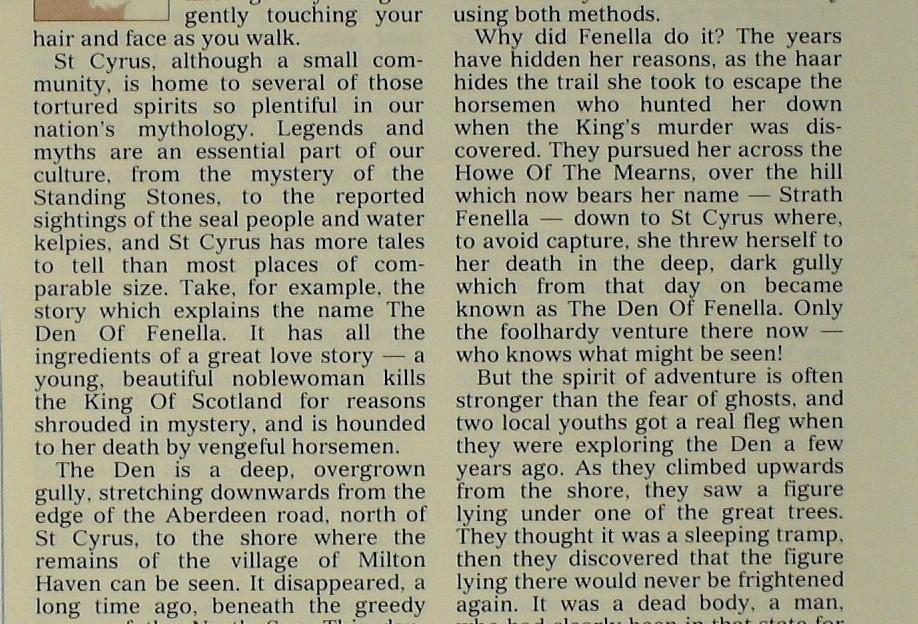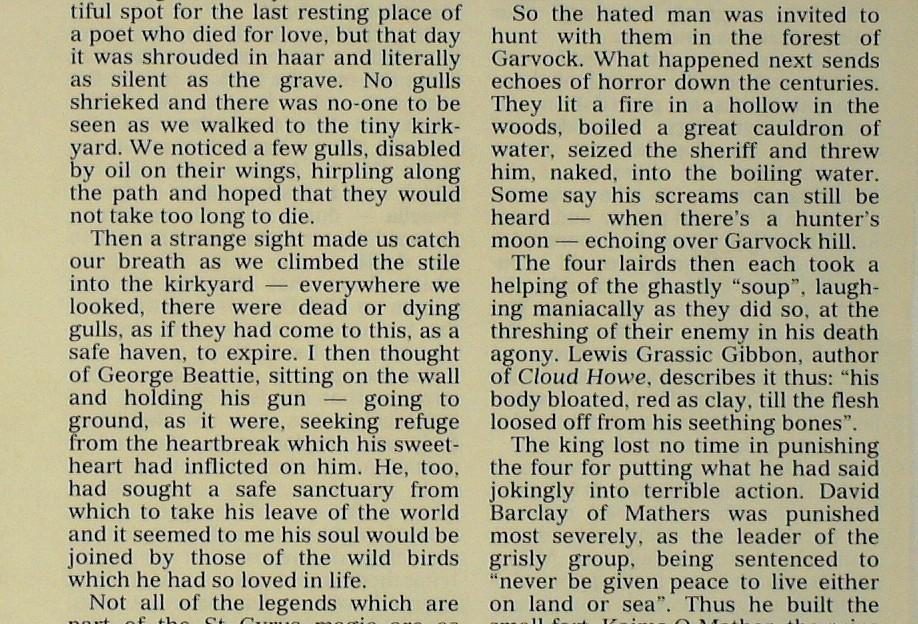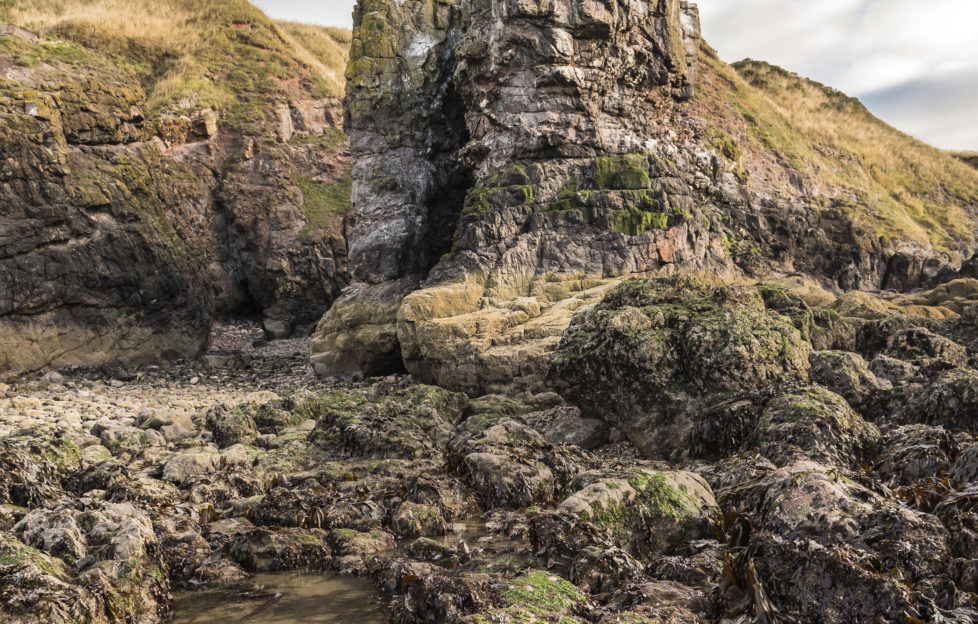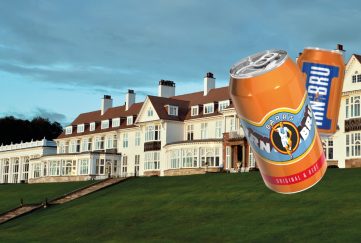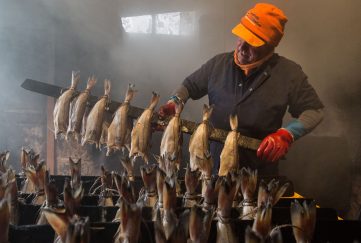Our Haunted Coast
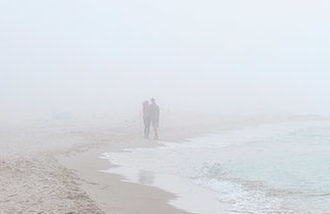
Jean Ross Anderson recounts the ghostly tale of Fenella and other supernatural stories from the Mearns…
Walking through the haar, as the soft, wet mist is called on the north-east coast, you cannot chase away thoughts of the ghosts which haunt this beautiful stretch of land. The haar itself is like ghostly fingers gently touching your hair and face as you walk.
St Cyrus, although a small community, is home to several of those tortured spirits so plentiful in our nation’s mythology. Legends and myths are an essential part of our culture, from the mystery of the Standing Stones, to the reported sightings of the seal people and water kelpies, and St Cyrus has more tales to tell than most places of comparable size.
Take, for example, the story which explains the name of The Den of Fenella. It has all the ingredients of a great story — a young, beautiful noblewoman kills the King of Scotland for reasons shrouded in mystery, and is hounded to her death by vengeful horsemen.
Dangerous but beautiful
The Den is a deep, overgrown gully, stretching downwards from the edge of the Aberdeen road, north of St Cyrus, to the shore where the remains of the village of Milton Haven can be seen. It disappeared, a long time ago, beneath the greedy waves of the North Sea. This dangerous but beautiful place is haunted by the ghost of the tragic beauty from whom it takes its name — Fenella.
Fenella’s story has been well documented in Scottish history, but it has become part legend as the years have gone by. She was the beautiful young wife of a north-east thane.
Kenneth (II) was on the throne of Scotland at the time, and she attended his court with her husband. One day, without warning, Kenneth was brutally murdered and evidence was said to point to Fenella as the culprit.
Stories vary about how she did the deed — some say that her weapon was a secret poison, brewed from herbs gathered in the Garvock Forest. Others say that she created a “mechanical device”, which fired an arrow into the king’s heart when he entered his private chamber, while some tongues suggested that she had made doubly sure of his death by using both methods.
Why did Fenella do it?
The years have hidden her reasons, as the haar hides the trail she took to escape the horsemen who hunted her down when the King’s murder was discovered. They pursued her across the Howe of the Mearns, over the hill which now bears her name — Strath Fenella — down to St Cyrus where, to avoid capture, she threw herself to her death in the deep, dark gully which from that day on became known as The Den Of Fenella. Only the foolhardy venture there now — who knows what might be seen!
But the spirit of adventure is often stronger than the fear of ghosts, and two local youths got a real fleg when they were exploring the Den a few years ago.
As they climbed upwards from the shore, they saw a figure lying under one of the great trees. They thought it was a sleeping tramp, then they discovered that the figure lying there would never be frightened again.
It was a dead body, a man, who had clearly been in that state for some time. A police investigation was set up to discover how the body got there and who it was.
The answer, if not as romantic as Fenella’s story, was equally sad. The man had been a hitchhiker. The lorry in which he had been travelling had had a slight accident in which the driver was dazed, and when he came to he thought that his passenger had simply left the scene, unhurt, to continue his journey. But instead he seemed to have been thrown or wandered into the Den.
No one had thought to search for him and he had died with only Fenella’s ghostly presence for company. There is an added eeriness about the place since that discovery — even the young and fearless give it a wide berth now.
Ghostly echoes
It is strange how ghosts from the past are sometimes linked across the years with strange happenings in the present. My sister Anna and I had a moving experience of this kind during a walk on St Cyrus beach.
We had decided to visit the poet George Beattie’s grave in Kirkside, the ancient burial place at the foot of the Heugh of St Cyrus. It is a beautiful spot for the last resting place of a poet who died for love, but that day it was shrouded in haar and literally as silent as the grave. No gulls shrieked and there was no-one to be seen as we walked to the tiny kirkyard.
We noticed a few gulls, disabled by oil on their wings, hirpling along the path and hoped that they would not take too long to die.
Then a strange sight made us catch our breath as we climbed the stile into the kirkyard — everywhere we looked, there were dead or dying gulls, as if they had come to this, as a safe haven, to expire. I then thought of George Beattie, sitting on the wall and holding his gun — going to ground, as it were, seeking refuge from the heartbreak which his sweetheart had inflicted on him.
He, too, had sought a safe sanctuary from which to take his leave of the world and it seemed to me his soul would be joined by those of the wild birds which he had so loved in life.
If you see seabirds troubled by oil on Scotland’s shores report it to the SSPCA (03000 999 999).
Not all of the legends which are part of the St Cyrus magic are as romantic as that of Fenella or George Beattie…
The stuff of which bad dreams are made…
The story of The Kaims O Mather could be straight from a horror film. It contains revenge, torture, cannibalism and exile. The perpetrators of the ghastly crime which led to the exile of their leader were four Highland lairds Mathers, Lauriston, Arbuthnot and Pittarow.
The victim was James Melville of Glenbervie, Sheriff of the Mearns, a man who was hated in the whole area for his contemptuous behaviour, particularly towards the lairds.
When they complained to King James I about him for the umpteenth time, he answered in the words which they took to be justification for their subsequent actions: “Sorrow gin he were sodden and supped in bree.” which roughly translated meant: “I don’t care if you make soup with him and eat it.”
So the hated man was invited to hunt with them in the forest of Garvock. What happened next sends echoes of horror down the centuries.
They lit a fire in a hollow in the woods, boiled a great cauldron of water, seized the sheriff and threw him, naked, into the boiling water. Some say his screams can still be heard — when there’s a hunter’s moon — echoing over Garvock hill.
The four lairds then each took a helping of the ghastly “soup”, laughing maniacally as they did so at the threshing of their enemy in his death agony. Lewis Grassic Gibbon, author of Cloud Howe, describes it thus: “his body bloated, red as clay, till the flesh loosed off from his seething bones”.
The king lost no time in punishing the four for putting what he had said jokingly into terrible action. David Barclay of Mathers was punished most severely, as the leader of the grisly group, being sentenced to “never be given peace to live either on land or sea”.
Thus he built the small fort, Kaims O’Mather, the ruins of which still stand beside the cliffs of St Cyrus, where he stayed until he was eventually pardoned. But he did swear never to sup broth again!
It is a harmless-looking ruin out there on the cliffs, but when it looms through the haar, there seems to be an evil presence about it. Sometimes the seagulls’ cry has a sound like the cruel laughter of demented men.


